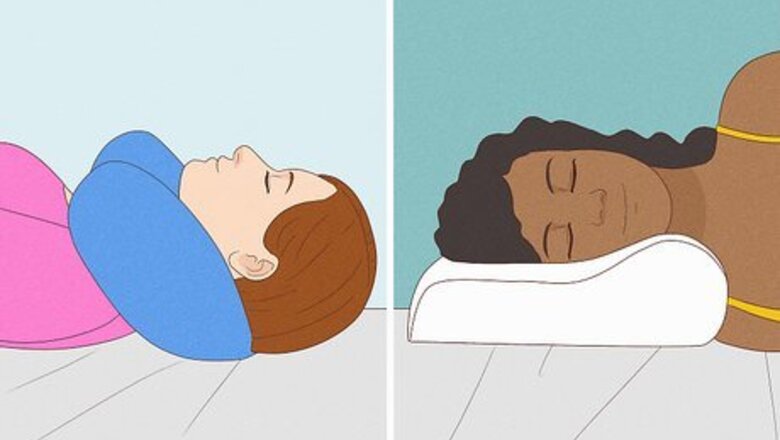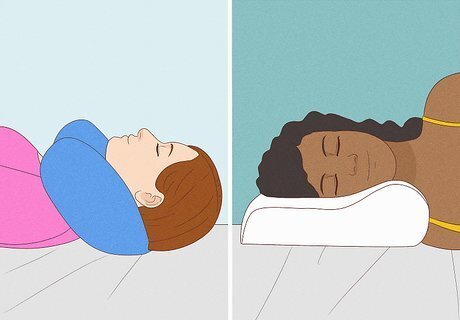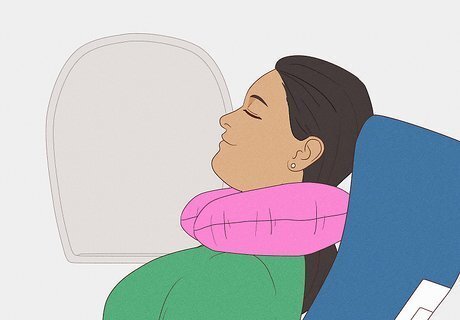
views
- In bed, try using a U-shaped neck pillow for sleeping on your back. Use a half-moon pillow or contour pillow if you sleep on your side.
- For maximum comfort, choose a pillow that fills the space between your neck and the mattress. Lay down so your neck stays aligned with your spine.
- To use a neck pillow while traveling, place it around your neck so the gap faces the back. Recline your chair and lean your head against the pillow.
Using a Neck Pillow in Bed

Choose a pillow that supports your sleeping position. When a neck pillow fits properly, it fills in the space between your neck and the bed so your spine stays aligned. The shape and type of pillow depends on whether you sleep on your back, side, or stomach. U-shaped neck pillows wrap around your neck and work best if you sleep on your back. Half-moon pillows are narrow and have a rounded shape to support your neck, and they’re best if you sleep on your back or side. Contour pillows have a wavy shape with an indent to rest your head. These pillows are best if you sleep on your back or side.

Rest your head and neck on the pillow. When you’re ready to go to bed, lie down so the pillow fills the space between your neck and the bed. Make sure your head and neck are aligned with your spine for the most comfortable night’s sleep. If your head is tilting forward, then your pillows are too thick or firm. Readjust the stuffing or find a thinner pillow. If you’re using a contour pillow, put the shorter side under your neck when you’re sleeping on your back and use the taller side for sleeping on your side. It may take a few nights to fully adjust to sleeping with your neck pillow.

Avoid neck pillows if you sleep on your stomach. When you sleep on your stomach, your spine, head, and neck are already aligned, so a flat pillow or no pillow at all will feel most comfortable. Put a pillow under your stomach and hips to help keep your lower back aligned and more comfortable. Sleeping on your stomach forces you to turn your head in one direction, which could cause it to feel sore in the morning.
Sleeping with a Neck Pillow while Traveling

Put the pillow around your neck so the opening is at the back. Fit the U-shaped pillow around your neck, and use the Velcro or fasteners to secure it in place. Then, turn the pillow around so the cushion is just below your chin. Putting the opening at the back gives your head and neck more support if you lean forward while you’re sleeping. If you have an inflatable neck pillow, locate the air valve and blow it up before putting it on. If the pillow feels too firm, open the valve and slowly let air out. If you have a wrap-style travel pillow, wrap it completely around your neck so the built-in support rests on your shoulder.

Recline your seat. Put your seat back by a few notches so you can feel more comfortable. Reclining supports your body in a more comfortable sleep position so you’re less likely to feel back pain when you wake up. If you’re sleeping on a plane, bus, or train, be considerate of the person sitting behind you and avoid reclining all the way back. If you’re not able to recline, put a cushion or jacket behind your lower back to support your spine. When you’re choosing a seat on a plane, try to pick a window seat near the front. It’ll be less noisy, you’ll be able to lean against the wall, and you won’t get woken up if someone needs to get up to use the restroom.

Lean back with your head on your pillow. Once you've got your seat reclined, lie back and close your eyes. Tilt your head so it rests on the pillow and keeps your neck supported while you sleep. If your neck pillow has stuffing such as beads or gel, bunch it up to one side to make it more firm and comfortable. Tie off the end with a hair tie or another item that will keep the stuffing from shifting.
Choosing a Neck Pillow

Choose a pillow material based on firmness and comfort. Some materials used to stuff pillows are better at supporting your neck than others depending on your sleep position. While some sleep positions need firmer materials, others need softer stuffing. Side sleepers: contoured memory foam or latex foam Back sleepers: down alternative, memory foam, latex foam Stomach sleepers: down, feathers, down alternative, polyester, or thin foam latex Combination sleepers: buckwheat hulls and multiple-material pillows

Consider other factors like your mattress and body size. Think about how soft your mattress is. If your mattress is on the softer side, it may cause your body to sink down more compared to your pillow. Get a softer or shorter pillow to compensate. If you have a smaller body frame, avoid thick or large neck pillows that could cause your head to tilt forward. If you get warm at night, consider a gel-foam cooling pillow or one filled with buckwheat hulls.



















Comments
0 comment